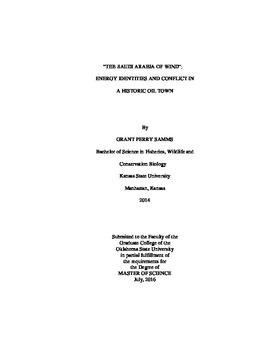| dc.description.abstract | While the number of installed wind turbines across the United States continues to grow, little research, especially qualitative research, has been conducted on the perceptions of those living near these installations. With a noted lack of theoretical consistency in this area of the environmental sociology literature, there is a need for detailed qualitative work. An intrinsic case study of Woodward, Oklahoma was conducted to help address these deficiencies. As a town economically based on petroleum production since the beginning of the twentieth century, the recent introduction of wind turbines and the city government�s claim to being �The Wind Energy Capitol of Oklahoma� have the potential to cause conflict. However, the overall perceptions of residents to wind power installations in Woodward appear neutral to positive. The most commonly cited benefits of wind power were economic, with development being seen as a boost to local businesses, adding local jobs, and increasing revenue for schools. While most respondents noted negative consequences, like traffic delays due to industrial trucking, most respondents also stated that the benefits far outweighed the �hiccups.� Others noted positive effects were environmental, such as improvement in local air quality, and community oriented benefits, such as the ability of wind development to give the town hope for a better future. Overall, both unquestioning support and opposition to wind power development in Woodward is rare. Most respondents qualified their stance toward the development. Additionally, respondents seem to have little issue with (or even knowledge of) the city government claiming that Woodward was a �wind town.� They explained the culture of their town as being an �energy city� or a �what works� city. In this way, wind energy was not in conflict with the area�s existing identities. Theoretically, evidence supports the use of sense of place or Social Representations Theory over the classily used Not In My Backyard (NIMBY) approach to explaining resident perceptions. Several instances were recorded that seem impossible under the simple NIMBY model, but are easily understood under a sense of place or SRT framework. | |
